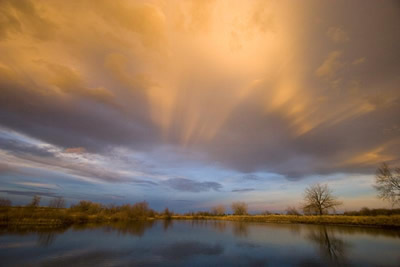Anti-crepuscular rays are beams of sunlight that appear to converge on a point opposite the sun. They are similar to crepuscular rays, but are seen opposite the sun in the sky. Anti-crepuscular rays are most frequently visible near sunrise or sunset. This photo of anti-crepuscular rays was taken at sunset in Boulder, Colorado. Crepuscular rays are usually much brighter than anti-crepuscular rays.
Click on image for full size
Image Courtesy of Carlye Calvin
Atmospheric Optics
Have you ever seen clouds in the sky that looked different than "normal" clouds? Or have you wondered why rainbows form? Sometimes there are phenomena in the sky that are affected by light and make clouds and the atmosphere look very colorful or unique. Atmospheric optics shows us how light behaves as it passes through the atmosphere. From rainbows to the northern lights, these optical features are dynamic and allow us to learn about atmospheric conditions. Some of these phenomena can be seen very often, and some are once in a lifetime sights.
In some instances, dust, small particles, and moisture droplets scatter light to make the sun's rays visible while clouds and mountain shadows are dark by comparison, creating crepuscular rays or anti-crepuscular rays. In other cases, air and very small particles can scatter colors selectively to make skies blue or sunsets appear to be on fire. Misty clouds and fog contain tiny water droplets that produce strange optical effects that are mostly ringed and brightly colored, including iridescent clouds and glory. Tiny ice crystals in the atmosphere can create halos by refracting and reflecting light.
There are many beautiful examples like these of light and color at work in the atmosphere. Visit the Photo Album of Atmospheric Optics and the Atmospheric Optics Image Gallery to see images of many types of these phenomena, as well as information on how they form.
You might also be interested in:
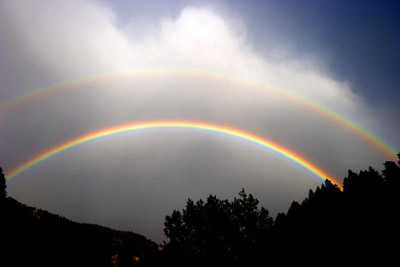
Rainbows appear in the sky when there is bright sunlight and rain. Sunlight is known as visible or white light and is actually a mixture of colors. Rainbows result from the refraction and reflection of
...more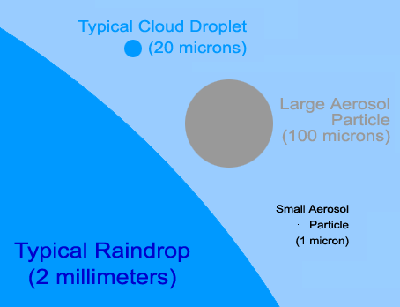
When you look up at the sky, you are looking at more than just air. There are also billions of tiny bits of solid and liquid floating in the atmosphere. Those tiny floating particles are called aerosols
...more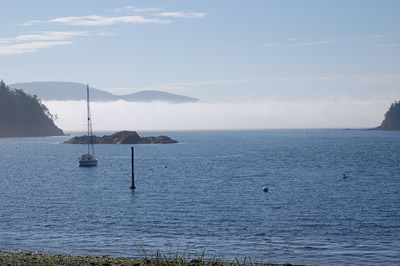
Fog is a ground-level cloud. There are several ways that fog forms. It usually forms when moist air travels over cold land or water. The moist air cools down and the water vapor condenses and forms a cloud
...more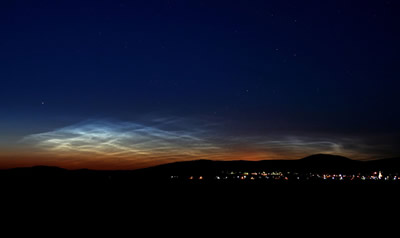
Noctilucent clouds (NLC’s) or polar mesospheric clouds (PMC’s) are found very high in the Earth's atmosphere. They are called Polar Mesospheric Clouds when they are viewed from space, and are referred
...more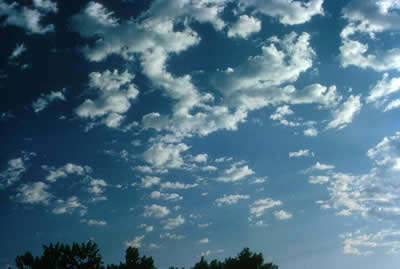
Altocumulus clouds are part of the Middle Cloud group (2000-7000m up). They are grayish-white with one part of the cloud darker than the other. Altocumulus clouds usually form in groups and are about
...more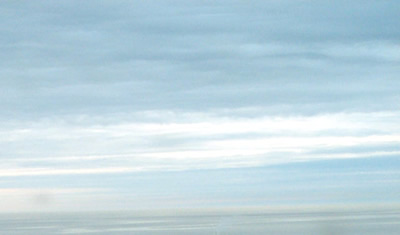
Altostratus belong to the Middle Cloud group (2000-7000m up). An altostratus cloud usually covers the whole sky and has a gray or blue-gray appearance. The sun or moon may shine through an altostratus
...more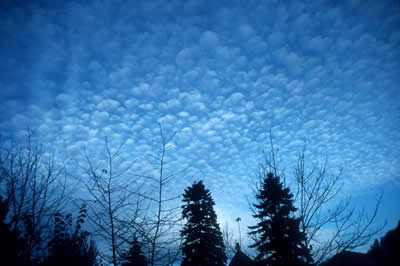
Cirrocumulus clouds belong to the High Cloud group (5000-13000m). They are small rounded puffs that usually appear in long rows. Cirrocumulus are usually white, but sometimes appear gray. Cirrocumulus
...more


